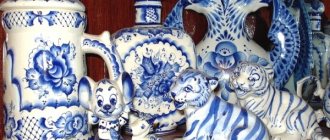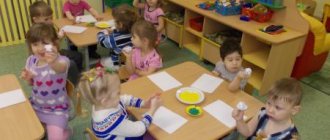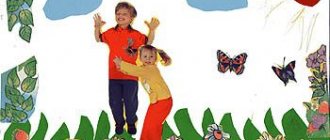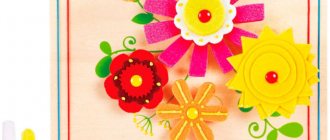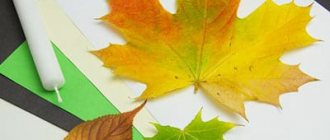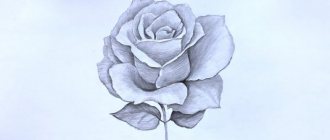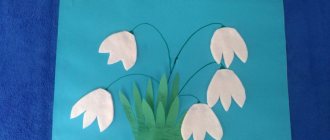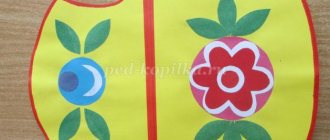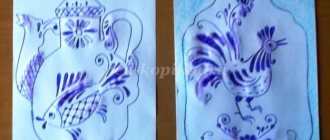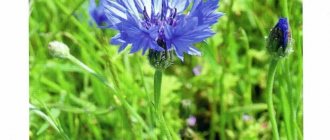Drawing notes for the preparatory group "Blue Flowers of Gzhel".
Behind business and worries, a quiet blue winter evening unnoticed falls to the ground... (Reading by the teacher of V. Fetisov’s poem “Winter Evening”)
A winter evening lit up the blue stars in the blue sky. The branches are pouring blue frost onto the blue snowball. Behind the branches the house turns blue, Covered with blue wool. Shadows walk along the wall like a bluish net. The frost paints blue in the windows of the forget-me-nots, And the blue dog yawns near the blue booth.
Maybe because the snow around is so dazzlingly white, and the evening shadows of Gzhel are so blue, and the frosty patterns on the windows are blue, and the sky above the village is clear azure, and Gzhel craftsmen chose blue paint on a snow-white background to paint their dishes. And since during the long winter we still dream about spring, master artists painted spring fairy-tale flowers with frosty patterns.
(Poem by A. Pleshcheev “Snowdrop”)
The last snowball has not yet melted, but the snowdrop flower is looking tenderly. After him, the violet woke up from sleep, She opened her purple eye. Here the lily of the valley turns white in the calm of the forest, the forget-me-not looks, bending over the stream.
The paints of the Gzhel masters have a secret: a nondescript gray powder (called cobalt), and the pattern on the dishes is gray. almost black. And as soon as they cover the finished crafts with glaze for shine and put them in the oven again for hardening, they will sparkle with magical blue and blue colors.
These are the wonderful works the Gzhel masters produced. (Showing reproductions and illustrations)
And the fame of the wonderful flowers of Gzhel spread throughout the world. Products from Gzhel craftsmen are considered a luxurious gift. The secrets of the craft have been passed down from generation to generation for more than 650 years.
In previous lessons we made forms for painting made from papier-mâché, and today we will try to paint them. Let's learn from real Gzhel masters.
The main elements of Gzhel painting are “wide and narrow stripe”, “dot”, “wave”, “bush”, “petal”, “mesh”, “leaf”. Display on a display sheet attached to the board.
A special technique that distinguishes Gzhel painting is the “stretching” of color, from dark blue to pale blue. This technique is performed “with the whole brush” due to an uneven amount of paint on the brush, a larger amount at the tip, a minimal amount towards the base.
Gzhel craftsmen use dry paint in powder. When working in watercolor or gouache, “stretching” the color can be achieved by applying an evenly colored stroke of blue paint and then using a dry, clean brush to remove excess paint from one side of the wide stroke.
Try painting elements on a sheet of paper and practice “stretching” the color. Now we will start painting papier-mâché plates, using only one paint - blue. Everyone will try to create their own pattern using traditional motifs of Gzhel painting. The composition of the pattern is a large pattern in the center and a small pattern along the edge of the product.
Progress of the lesson
The teacher reminds that winter is coming to an end, suggests remembering the colors in which the children painted winter landscapes , thinking about what colors are most suitable for Winter, what kind of dishes she might like. Draws attention to the stand with products of Gzhel craftsmen.
Questions: - What is the name of the painting that decorates all these products? - How did you guess that it was Gzhel?
-What colors are characteristic of Gzhel painting?
— What elements of painting do you know? Name them.
-What material is Gzhel tableware made of?
— Name the familiar items of Gzhel dishes and their purpose.
-What color is the background of Gzhel dishes?
— What is the favorite element of Gzhel craftswomen?
How do Gzhel craftsmen make their dishes?
— Why is it called Gzhel? How are all the dishes decorated? ( Flowers , leaves, birds, twigs.)
The teacher clarifies that Gzhel dishes are painted with blue paint of different shades on a white background and, in their color scheme, are very suitable for winter flavor . Invites children to decorate dishes for Zimushka-winter. Reminds me that unusual blue-blue flowers on dishes will delight Zimushka, because any girl likes flowers .
Shows a new element of painting - the Gzhel rose, the most favorite flower of the craftswomen of this craft. Shows children examples of how to perform this element and reminds them of the sequence of drawing andvetka .
— The basis of the image of a Gzhel rose is a brushstroke with a shadow. This is a special tonal stroke in which the transition from dark to light shades of blue is clearly visible . To obtain a good stroke, it is very important to correctly distribute the paint on the brush - there should be no more paint towards the edge, and less towards the middle. (Shows and comments on the process of making a Gzhel rose.)
Children's master class on drawing in an unconventional technique “Winter patterns” Materials for completing the master class: blue paper, a simple pencil, PVA glue, semolina (expired, past the expiration date. Lesson on the application “Flowers” Program tasks: improve the work with scissors - cut the paper into narrow strips, cut circles from squares; exercise the skill. Notes on non-traditional drawing "Flowers" Objectives: expand children's knowledge about flowers, their diversity; teach children to draw flowers using unconventional drawing techniques; develop. Notes NOD for drawing “Winter Sports” in the preparatory group On FEBRUARY 4 in Sochi, the All-Russian Day of Winter Sports was celebrated, dedicated to the third anniversary of the opening of the Olympic Winter Games 2014. Summary of a lesson in drawing in mixed media “Winter Trees” Objectives: to develop children’s cognitive interest, cultivate an aesthetic perception of the winter landscape; enrich vocabulary; teach children to draw.
Speech therapy lesson in a school-preparatory group for children with STD on the lexical and grammatical topic “Winter fun” Speech therapy lesson “Winter fun” in a school-preparatory group for children with STD (OND) on the lexical and grammatical topic “Winter”. Target:.
Project lesson “Children are the flowers of life” Objectives: Involve children and parents in creative activities, during which, thanks to communication and cooperation, they will become closer. "Winter fun" Lesson-walk in the senior group Progress of the walk: Children go out to the site with a teacher. 1. Observation of the bushes. The teacher and the children approach the bushes: Which one. Drawing lesson “Flowers as a gift for mom” Drawing lesson with gouache paints “Flowers as a gift for mom” in the middle group. Goal: To create a desire to draw as a gift for mom on March 8th. Lesson on drawing from life in the senior preparatory group “Flowers in a vase” Lesson on drawing from life in the senior preparatory group on the topic: “Flowers in a vase” Educator: Panova Irina Sergeevna Quantity.
Source
Program content: To introduce children to Gzhel porcelain, its characteristic features: the shape of the products, their purpose and patterned design in content, color, composition
To expand children’s knowledge about artistic crafts, to cultivate love and respect for folk traditions in art and its masters.
Progress of the lesson
An exhibition of Gzhel dishes is organized in the hall: samovars with teapots, a sugar bowl, an oil dish, a vase, a lion milkman, a cat sculpture
Book by N. Suryaninova “Blue Flowers of Gzhel”, postcards, illustrations. Badges for each child with a picture of a Gzhel rose on a circle.
Teacher's story:
— We came to an exhibition of dishes decorated with blue painting, they call it “Gzhel”. Based on the name of a small village near Moscow. Porcelain products are created in factories there. And these products are so good, people loved them so much that the fame of Gzhel masters spread not only throughout the country, but also far beyond its borders.
I like Gzhel primarily for its blue color. The Gzhel people themselves say that their sky is blue, blue. So they decided to transfer this blue to white porcelain.
Each artist comes up with his own vases, oil dishes, teapots, milk jugs, and sugar bowls. There are so many artists, so many different forms. And they are always unusual - cheerful, beautiful.
(They look at a samovar, a flower vase).
-Every thing made in Gzhel is interesting to look at and admire. Admire it too. Gzhel masters are great dreamers. Some cups are slender and tall, others look like a small barrel, and other figures are intricate. And everyone’s hands are different. When you see Gzhel teapots, your eyes widen. They are very good!
Look at this lion, he is not afraid of anyone, he is even a little funny, his mane is like a rose!
The artist’s hand moves a brush with paint along the white background of the cup, pressing it harder and weaker. And everything he draws becomes blue and blue - both flowers and grass. Just one paint, and what an elegant and festive painting it turns out to be!
The border is placed along the edges. (Suggests considering a samovar, sugar bowl).
-The most favorite pattern is the Gzhel rose. Sometimes it is depicted large, with broad strokes (shows on small and large teapots), and sometimes it is painted with a thin brush.
And it also happens: there is no rose itself, but only its petals (they examine).
The teacher invites the children to look at the products again, paying attention to the shapes and patterns. Gives children the opportunity to share their experiences.
Questions:
1.What elements of the pattern are used by Gzhel artists to decorate dishes.
2.What did you like most about the exhibition?
In memory of the exhibition, the teacher gives the children badges (circles with a diameter of 5 cm on which she drew different flowers).
Summary of OD with children of senior preschool age “Folk masters of Gzhel”
Olga Maksimova
Summary of OD with children of senior preschool age “Folk masters of Gzhel”
1. Continue to expand children’s understanding of decorative and applied arts, instilling interest in the origins of Russian folk culture .
2. Introduce children to the history of the Gzhel craft in Russia and the main elements of painting.
3. Learn to knead and prepare salt dough; give the intended shape, developing fine motor skills of the hands.
4. Learn to draw using one color in a painting, develop the ability to compose shades of blue using a palette.
5. Continue to develop the skill of drawing with the whole brush and its end, developing an interest in the variety of patterns.
6.Enrich and activate children's vocabulary: fishing, Gzhel , Zhgel, potter's wheel, clay, etc.
7. Foster respect for the work of folk craftsmen ; interest in the origins of Russian traditions.
8. Arouse a positive emotional response and desire for the creative process.
1. Aleksakhin N. N. Artistic crafts of Russia.
2. Khalezova N. B. Decorative modeling in kindergarten.
3. Dankevich E. Modeling from salt dough.
4. Lopukhina I. S. Rhythm, speech, movement.
5. Presentation “ Folk Masters of Gzhel ”
.
6. Using fragments of the Russian folk melody “Fair”
.
— Sheets or strips of paper
- simple pencil, blue and white gouache
- visual material depicting Gzhel painting
- Gzhel dishes , figurines
- thin brushes for painting and thick ones
— prepared presentation about the origin of the craft and folk craftsmen
- CD of Russian folk music
- molds for modeling
— game “Russian souvenir”
— Conversation between a teacher and children about Russian folk traditions and the Gzhel
— Examination of Gzhel , illustrations with elements of painting
— preparing salt dough for joint activities; blanks for painting
— visit to the Russian hut at the GBDOU
– excursion to the library: Russian folk craft “ Gzhel ”
Organization of joint activities:
Part 1 – introductory (conversation with children about Gzhel , watching the presentation “ Folk Masters ”
).
Part 2 – practical (working with a palette, color on paper blanks; working with forms prepared from salt dough).
Part 3 – final (examination of children’s works, conversation, game “Russian souvenir”
).
Abstract of the educational activity “Travel to Gzhel”
Legun Irina
Abstract of the educational activity “Travel to Gzhel”
SUMMARY OF NOD “ TRAVEL TO GZHEL ”
(integration of educational areas: “Cognitive development”
+
“Speech development”
+
“Artistic and aesthetic development”
using ICT)
Goal: To expand preschoolers’ understanding of objects of the man-made world in the system of work to familiarize themselves with folk art
Learn to highlight the traditional features of Gzhel painting : white background and blue-blue pattern
Deepen children's knowledge about folk artists and the unique Gzhel culture
Learn to recognize the quality and properties of objects
Learn how to apply strokes (paint)
on the product, create expressive patterns on paper and on three-dimensional objects
Develop children’s ability to listen to each other and communicate freely in small groups
Develop cognitive activity and interest in objects of the man-made world
Intensify children's attention to studying and identifying the characteristics of the cultural heritage of their people, their country
Develop skills in a creative approach to doing work
Foster a love for the origins of native culture
To cultivate a sense of form, color, symmetry, admiring the richness and true beauty of the man-made world,
Foster a desire to help loved ones, empathize, care and maintain the harmony of nature
Preliminary work: examining Gzhel , drawing, stories about folk craftsmen, reading fiction, plaster modeling, visiting and creating a mini museum.
«Travel to Gzhel»
Color scheme of Gzhel painting
Traditionally, the design is done only in shades of blue. Against the background white color of porcelain, the master is able to convey the entire palette of the universe with one color. But blue can be different: from faded blue to expressive deep blue, turning into shades of night. A dark cobalt color is also used. And the laconic Gzhel pattern is completed with platinum or gold decor.
And before that, Gzhel popular print was popular, when the craftsmen painted the dishes with blue, yellow, brown and purple paints, all on the same white background. But the most beautiful handicrafts are considered to be overglaze samples: the craftsman applied colored paints directly over the glaze. After this, dishes or other products must undergo three or even four firings.
